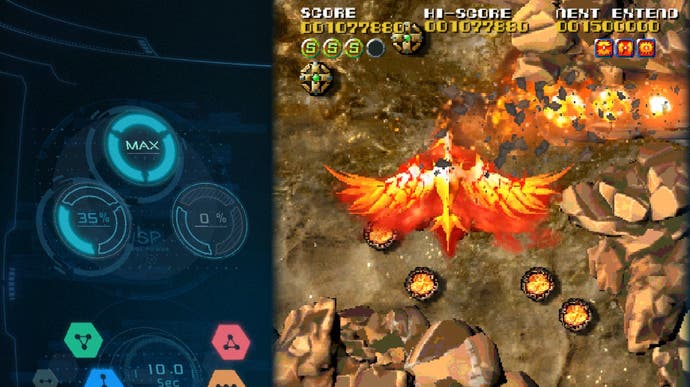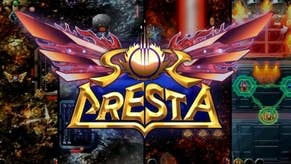Sol Cresta review - distinctive, but slightly untidy shooting thrills
The life and Sol?
You could forgive the team at Platinum if they built their debut in the 2D shooter genre from the conventions of bullet hell.
The style made famous by Toaplan, Cave and their peers, after all, is often projected as the genre's higher form, with its preference for excess commonly dazzling players, collectors and press alike. All of that might make bullet hell particularly appealing to a studio more typically focussed on energetic, happily excessive triple-A action games.
With Sol Cresta, however, Platinum are extending a series that began almost 42 years ago with Nichibitsu's 1980 release Moon Cresta. Back then, even the titles that started to hint at what might be possible with high bullet counts were over a decade away. Moon Cresta's was an era before danmaku, and the Bayonetta studio has made an impressive commitment to respecting the genre's conventions as they were through the first half of the 1980s.
That's not to say Sol Cresta feels exactly like a shooter from that time. Rather, Platinum have undertaken a substantial effort to modernise the classic genre template, embellishing it with an intricacy and pace informed by contemporary titles, while making sure it is faithful to what shooters were over four decades previously.
The result is a game that certainly feels distinct when compared to most contemporary shooters; and especially within those tied to arcade culture and Japan's prolific shooter development scene. Rather than concern players with threading a pixel-sized hitbox through billowing streams of neon bullets while insisting they manipulate a wildly complex scoring system, Platinum has built a game built around a player ship with a dizzying range of abilities.
Back when Moon Cresta was cutting edge, it introduced a fairly innovative 'docking' system at a time when so many 2D shooters were deeply formulaic, often openly cloning the bankable formula of hits like Galaga and Space Invaders. While Moon Cresta itself in fact began life as a Galaxian hack, in letting the player power up their ship by attaching additional parts, it did much to stand out from its rivals.
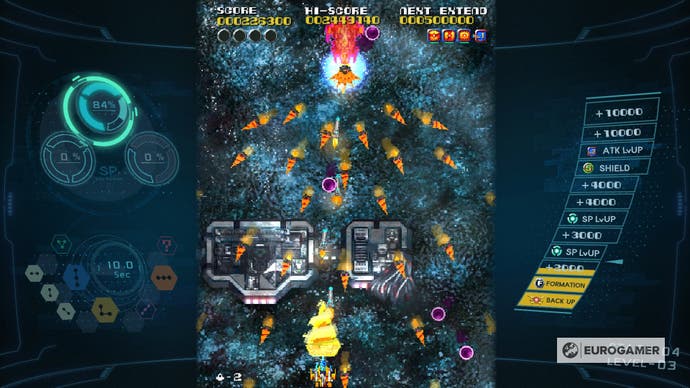
Platinum has taken that foundational concept and run with it, giving Sol Cresta's protagonist attack vessel so many intersecting abilities that to play is initially strikingly bewildering. The core player ship is a basic, underpowered and ultimately vulnerable craft that brings about as much kick as a peashooter. Quickly, though, power ups appear that let you connect a second and then third such ship to your main fighter. With each new element you dock, the flexibility and ability of your weapons system is greatly increased.
And so it is that you pursue piloting a vessel made from three smaller ships, each with distinct weapons on board, and their own special attacks. The yellow ship offers a destructive straight shot, the blue lets rip with powerful if imprecise homing missiles, and the red has a weaker spread attack. That colour coded delineation is important, because it lets you track which craft is which as you separate and reconnect the ships to create different cocktails of ordnance. Depending on which you position at the front, middle or rear, you can prioritise different main shots and special weapons - the latter of which unleash a destructive volley via a charge of the shot button
Hit the 'split/dock' button and time in the game slows down as your ships divide from one another, while a ribbon of otherworldly electro cable connects them as one. Move them into a new arrangement - perhaps shifting blue to the front, followed by red and then yellow - and with a stab of a button they merge as one and your new weapons system is instantly ready.
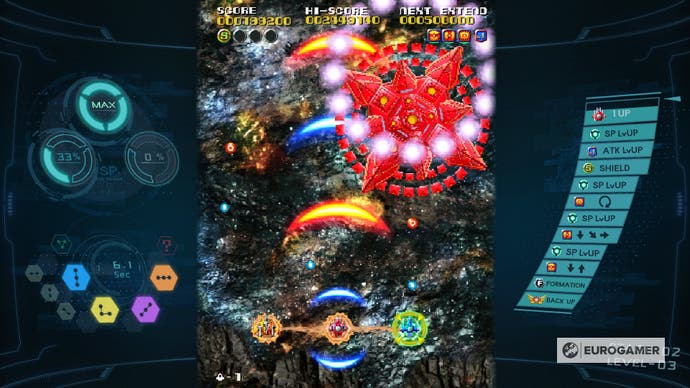
That is only the beginning, though. You can also unleash additional attacks in different directions using rotational inputs that will be familiar to anyone that's spent much time with a fighting game. Quite remarkably, rotating a stick and jabbing a button to send a directional while also using that same stick to move your ship works rather well - though it is a easily forgotten ability in the chaos of battle, and you can make plenty of progress towards the seventh and final stage without ever needing to use it.
The same can be said of yet another way to take advantage of the docking system. With your ships separated, you can arrange them into various formations, rather than choose to reconnect them. Adopting one of six formations gives you a brief window immensely powered up. By doing the likes of surrounding you with spinning lasers or turning you into a gigantic indestructible phoenix, these attacks can be tremendously helpful in getting you out of a tight spot. But once again, with so many weapon options and variations to tinker with as you get on with the core job of shooting and dodging, it is easy to fall into the habit of using the standard weapons, while cruising to the later levels without needing to let out a single formation attack.
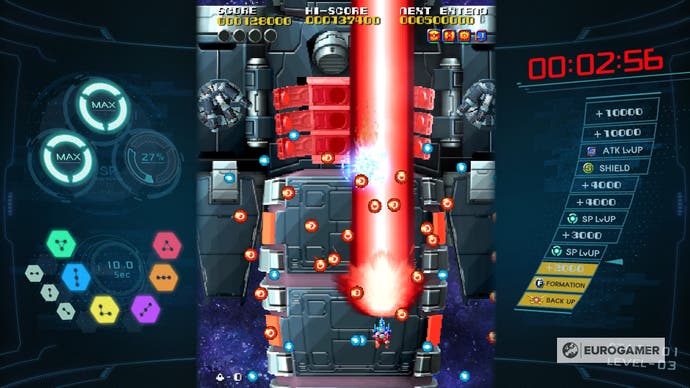
All of those systems are tied together by two core in-game resources. Killing enemies fills an SP gauge, which is spent on those charged special shots and the more devastating formation attacks. Collecting the titular Sol coins dropped by downed foes, meanwhile, fills a reward metre which constantly grants new abilities, score boosts, extra lives and so on.
There's also a shield system in place, and a life is not over until your last ship element has taken a hit, making Sol Cresta rather generous in how much damage you can endure before being blown from the heavens.
Away from all those systems, Sol Cresta is a lengthy game by genre standards, with far from brief levels that become more complicated as they pass. It makes increasingly heavy use of moving scenery and tight, claustrophobic sections as you progress through the stages, and continually shrinks the quieter moments that let you pause for breath. It really is exciting to play - and even at the lower difficulties you're assured a thrilling ride with plenty of gasps and close shaves. Sol Cresta - which famously started life as an apparent April Fools joke - also has a knack for delivering dramatic credits defined by fighting back from oblivion, as you rebuild a damaged ship from peashooter status back to intergalactic powerhouse.
"If anyone was expecting a work of minimalism from Platinum, they were only setting themselves up for disappointment."
However, with so many systems at your disposal, it often feels a little inelegant. Looked at one way, Sol Cresta's intersecting systems provide a generous capacity for different play styles. You can pick what works for you, and ignore the rest. A little too often, though, it's easy to get lost to fiddling with formations and arrangements and such, distracting yourself being truly engrossed. However, unlockable high-score modes with online leaderboards such as a caravan arrangement give you plenty of motivation to overcome and stay focused.
Playing the pre-release code, it should be said that the game hung and stuttered momentarily on PS4, but - fortunately - only in moments transferring between stages, where it had little to no impact. Elsewhere, the display options seem well intended but misplaced. There's options to rotate the display and add scanlines - but the latter feel so dense they cloud the action rather than sharpen it. Set scanlines to 'heavy' and it can feel like the game is totally lost behind it's display settings.
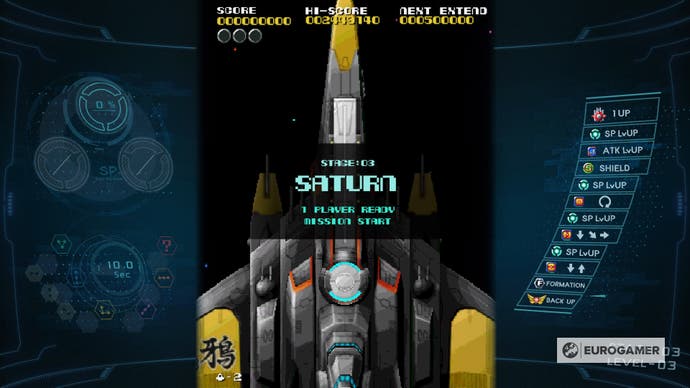
Visually, Sol Cresta will likely be divisive. It brings something of a scrapbook of styles from the various looks that have defined the genre over the decades, and eagerly throws them together. The results are visually busy and then some, and while many may see a charmingly eccentric aesthetic informed by the glint in Platinum's eye, others might feel too many elements simply clash. There is a little inconsistency to the quality, with some enemy sprites looking wonderful, and others a little poorly defined.
The audio, meanwhile, is straight up sublime, with sound effects that inherit the notion of modernising a classic form, and a musical score that capably matches Sol Cresta's drama and energy. In fact, it is the music that stands out most in Platinum's creation, rivalling the soundscapes of the genre's best works.
Sol Cresta may not be perfect, but it is absolutely fun, atypical and thrilling. Those, surely, are exactly the qualities we'd want from a studio that turned its attention to 2D shooters after crafting works like Bayonetta. A Cave-like would, frankly, have been disappointing. Instead, we've got something hard to pin down. At times it feels like Sol Cresta has rather too much going on. But that is infinitely better than having too little going on. And if anyone was expecting a work of minimalism from Platinum, they were only setting themselves up for disappointment.
